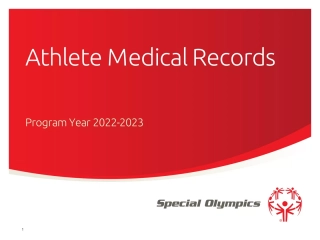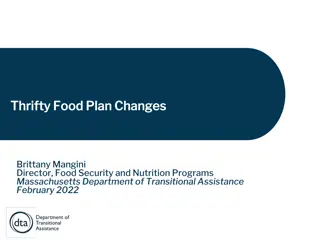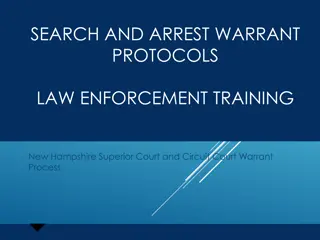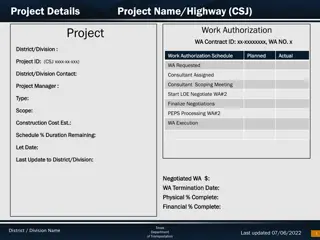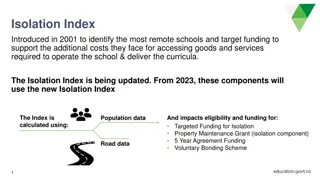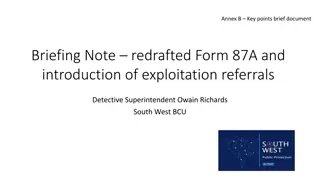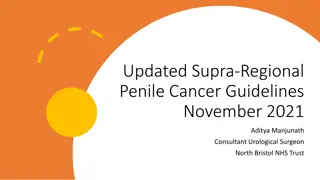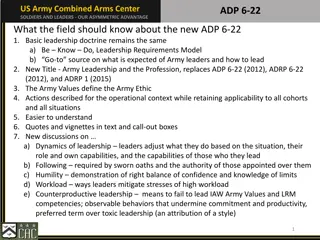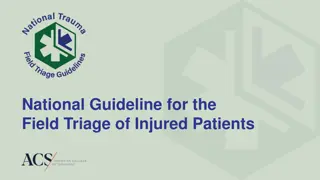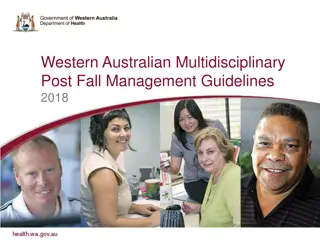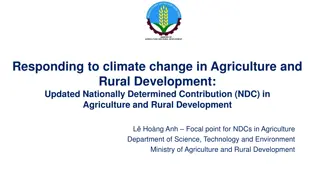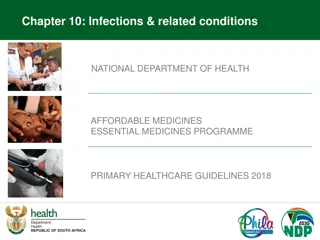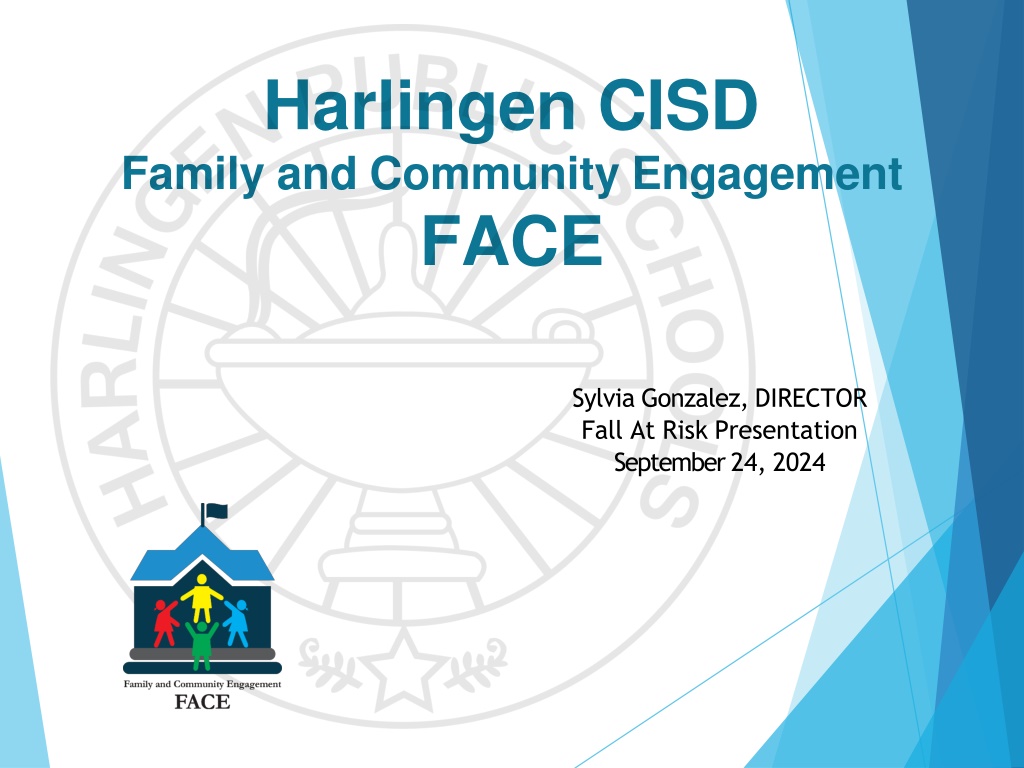
Identifying At-Risk Students in Education System
Learn about the criteria for identifying students at risk of dropping out of school, including age-related indicators, academic performance standards, and social circumstances. Find out how to code and report at-risk students using state-defined criteria to provide necessary support and intervention for their academic success.
Download Presentation

Please find below an Image/Link to download the presentation.
The content on the website is provided AS IS for your information and personal use only. It may not be sold, licensed, or shared on other websites without obtaining consent from the author. If you encounter any issues during the download, it is possible that the publisher has removed the file from their server.
You are allowed to download the files provided on this website for personal or commercial use, subject to the condition that they are used lawfully. All files are the property of their respective owners.
The content on the website is provided AS IS for your information and personal use only. It may not be sold, licensed, or shared on other websites without obtaining consent from the author.
E N D
Presentation Transcript
Harlingen CISD Family and Community Engagement FACE Sylvia Gonzalez, DIRECTOR Fall At Risk Presentation September 24, 2024
Students in At-Risk Situations Criteria to Entera Studentas At-Risk Training At-Risk-Matrix 2024-2025 At-Risk coding must be completed in the Student s Programs-146 PEIMS State Reporting Demographics Screen and the 546-At-Risk Program Screen District.
AT-RISK-INDICATOR-CODE AT-RISK-INDICATOR-CODE Indicates whether a student is currently identified as at-risk of dropping out of school using state-defined criteria only (TEC 29.081, Compensatory and Accelerated Instruction). A student at-risk of dropping out of school includes each student who is under 26 years of age and who:
Definition AT-RISK-INDICATOR-CODEindicates whether a student is currently identified as at-risk of dropping out of school using state- defined criteria only (TEC 29.081, Compensatory and Accelerated Instruction). A student at-risk of dropping out of school includes each student who is under 26 years of age and who: 1.is in prekindergarten, kindergarten or grade 1, 2, or 3 and did not perform satisfactorily on a readiness test or assessment instrument administered during the current school year; 2.is in grade 7, 8, 9, 10, 11, or 12 and did not maintain an average equivalent to 70 on a scale of 100 in two or more subjects in the foundation curriculum during a semester in the preceding or current school year or is not maintaining such an average in two or more subjects in the foundation curriculum in the current semester; 3.was not advanced from one grade level to the next for one or more school years; (Note: From 2010-2011 forward, TEC29.081(d-1) excludes from this criteria prekindergarten or kindergarten students who were not advanced to the next grade level as a result of a documented request by the student s parent.) 4.did not perform satisfactorily on an assessment instrument administered to the student under TEC Subchapter B,Chapter 39, and who has not in the previous or current school year subsequently performed on that instrument or another appropriate instrument at a level equal to at least 110 percent of the level of satisfactory performance on that instrument; 5. is pregnant or is a parent; 6.has been placed in an alternative education program in accordance with TEC 37.006 during the preceding or current school year; 7. has been expelled in accordance with TEC 37.007 during the preceding or current school year; 8. is currently on parole, probation, deferred prosecution, or other conditional release; 9.was previously reported through the Public Education Information Management System(PEIMS) to have dropped out of school; 10.is a student of limited English proficiency, as defined by TEC 29.052; 11.is in the custody or care of the Department of Protective and Regulatory Services or has, during the current school year, been referred to the department by a school official, officer of the juvenile court, or law enforcement official; 12. is homeless, as defined by42U.S.C.Section11302,,and its subsequent amendments; or 13.resided in the preceding school year or resides in the current school year in a residential placement facility in the district, including a detention facility, substance abuse treatment facility, emergency shelter, psychiatric hospital, halfway house, or foster group home; or 14.has been incarcerated or has a parent or guardian who has been incarcerated, within the lifetime of the student, in a penal institution as defined by Section 1.07, Penal Code. Regardless of the student's age, participates in an adult education program provided under a high school diploma and industry certification charter school program under Section 29.259. 15. is enrolled in a school district or open-enrollment charter school, or campus of a school district or open-enrollment charter school, that is designated as a dropout recovery school under TEC 29.259.
Important Dates School Year 2024-2025 October 25, 2024 Snap Shot Date InternalDeadline for Coding TBA FirstSubmission TBA Resubmission TBA
LEA Responsibilities LEAs are responsible for: 1.submitting current, complete, and accurate data for all record groups required for each collection; 2.validating and editing data according to edit rules in the PEIMS Data Standards; 3.correcting all errors found by the ESC during the data validation process in a timely manner; and 4.delivering fatal-free corrected data on or before the due dates set by their ESCs and TEA. LEAs are responsible for meeting the ESC established due dates for each collection. The ESCs establish due dates to allow sufficient time to process and accept LEA data before the TEA deadline for each collection (see the PEIMS Submission and ResubmissionTimelines). Superintendents/Chief Administrative Officers/ Chief Executive Officers/ Presidents of LEAs are responsible for submitting the electronic "Superintendent s Statement of Approval of Summary Report and Error Listing" (SAF) for each submission and resubmission based on the final review of the LEA s PEIMS data file. The electronic signature (SAF) certifies 1.the LEA has submitted all required data with zero fatal errors; 2.the LEA has verified the accuracy and the authenticity of the data submitted for the collection; 3. the data presented in the summary reports and all warning messages in the edit error listing have been reviewed for accuracy; and 4.the accuracy and authenticity of the data submitted for the collection. The electronically signed SAF form is stored on a secured TEA server and a copy is emailed to the email addresses listed in EDIT+ under SAF administration for the LEA.
Submission Descriptions: Collection 1 represents the state of the LEAs as of the Fall Snapshot date. Although the Fall Snapshot Date may not be a day of instruction, LEAs still report all students served and staff employed on that date. Exception: Leaver data are reported based on leaver status as of the last Friday in September. Collection 2 includes the audited actual financial data for the prior school year. Collection 3 includes year long student attendance (regular and flexible), course completions, disciplinary actions, student restraints, Title I, Part A participation, course sections, and teacher class assignments/staff data. Collection 4 includes special education extended year services (EYS) student data for the school year, student flexible attendance for credit recovery, and summertime dual credit completions for students.
Location of Supplemental Documentation - At-Risk StudentProfile (Cognos Report) -Path:eSchool Plus->Cognos Reporting->PEIMS Folder-> PEIMS At-Risk Student Profile. -Profile must be filed for every At-Risk student with criteria s 5,8,11,14.15 -For criteria s 5,8,11,14.15 the supplemental information will be collected through the At-Risk Student Profile - CreateAt-Risk Binder -Documentation for criteria s 1,6,7,13 Student s Cum Folder -Documentationfor criteria s 2,3,4,10 Criteria 15 -At-Risk: Student Profile Note: Secondary Alternative Center and Secondary Campuses will keep information for criteria 6 and 7, Data Governance Outcomes will keep information for criteria 9 , Family and Community Engagement Dept. will keep information for criteria 11 & 12.
Criteria 1 Did not meet mastery level. GradesPre-k-3rd Pre-k3 or 4, kindergarten, grade 1, 2, or 3, and did not perform satisfactorily on a readiness test or assessment instrument administered during the current school year. Grade Assessment At Risk Measure Pre-k 3 Circle Progress Monitoring Rapid Letter Naming Phonological Awareness Math Total Red Score Red Score Red Score Pre-k 4 Circle Progress Monitoring Rapid Letter Naming Vocabulary Phonological Awareness Math Total Yellow or Red Score Yellow or Red Score Red Score Red Score
Criteria 1 Did not meet mastery level. GradesPre-k-3rd Pre-k 4, kindergarten, grade 1, 2, or 3, and did not perform satisfactorily on a readiness test or assessment instrument administered during the current school year. Grade Assessment At Risk Measure One grade below Two grades below Three or more grades below Kindergarten i-Ready Reading Math One grade below Two grades below Three or more grades below 1st Grade i-Ready Reading Math One grade below Two grades below Three or more grades below 2nd Grade i-Ready Reading Math One grade below Two grades below Three or more grades below 3rd Grade i-Ready Reading Math
All students below the black line would be considered At-Risk
Criteria 2 Cum Student is in grade 07-12, did not maintain an average equivalent to 70 on a scale of 100 in 2 or more subjects in the foundation curriculum (core courses) during a semester in the preceding or current school year. Student is in grade 07-12, did not maintain and average equivalent to 70 on a scale of 100 in 2 or more subjects in the foundation curriculum (Core Courses) during a semester in the preceding or current school year or is not maintaining such average in 2 or more subjects un the foundation curriculum (Core Courses) in the current semester.
Criteria 3 Cum Was not advanced fromone grade level to the next for one or more school year (s). Was not advanced from one grade level to the next for one or more school year (s) (Note: From 2010-2012 forward, TEC29.081 (d- 1) excludes from this criteria prekindergarten or Kindergarten students who were not advanced to the next grade level as a result of a documented request by the student s parent.) This is a permanent code that follows the student until he/she graduates.
Criteria 4 Cum Did not perform satisfactorily on an assessment instrument administered to the student under TEC Subchapter B, Chapter 39, and who has not in the previous or current schoolyear. This criteria includes:STAAR, STAAR/EOC. Did not perform satisfactorily on an assessment instrument administered to the student under TEC Subchapter B,Chapter 39, and who has not in the previous or current school year subsequently performed on that instrument or another appropriate instrument at a level equal to at least 110% of the level satisfactorily performance on that instrument. This criteria includes:STAAR,STAAR/EOC
Criteria 4Cum For STAAR 3-8: First time STAAR taker: If the student failed to meet Approaches standard, the student remains At Risk. If the student was previously coded At Risk and failed to meet 110% passing, the student remains At Risk. For STAAR,EOC: First time STAAR,EOC taker: If the student failed to meet Approaches standard, the student is considered At Risk.
Criteria 4Cum If the student was previously coded At Risk for a failed examination and failed to meet 110% passing on the same EOC examination, the student remains At Risk. Additional information can be found at TEA website frequently asked questions: http://www.tea.state.tx.us/index4.aspx?id+4082
Criteria 4 2023-2024 Process Change DMAC has a report titled STAAR Performance 110% that can assist campuses identify and code students. Campuses are responsible for verifying students how are identified. Data Governance & Outcomes will work with DMAC on a solution to support campuses mass update applicable students. More information forthcoming.
Criteria 5 At-Risk Student Profile Student is pregnant or is a parent. Is pregnant or is a parent.
Criteria 6 Binder Has been in an alternative education program in accordance with TEC Chapter37.006 during the preceding or current school year. Has been placed in an alternative education program in accordance with TEC Chapter 37.006 during the preceding or current school year. At-Risk Coding Responsibilities: New Pathways (Elementary APs or designee) Secondary CAEP (Home Campus APs or designee) SAC placements (D. Araiza SAC admin) Discipline incident reason codes not included under this criteria are 01,20,21- 21g,22- 22c,33,34,41. Please visit with Mr. Dan Araiza (6th Through 12th ) 427-3210 for more information
Criteria 6Binder Mr. Daniel Araiza (Secondary Alternative) will provide a list of students to the person in charge of coding at the campus level of all students placed in an alternative education program (SAC, CAEP, or New Pathways) in accordance with TEC Chapter37.006 during the preceding or current school year up until October 11, 2024. Discipline incident reason codes not included under this criteria are 01, 20, 21-22g, 22-22c, 33, 34, and 41. This list will be provided on October 21, 2024 so that coding may take place at the students home campus. Any other students currently at the Alternative Center after that date will be coded by Mr. Daniel Araiza. Home Campuses are responsible for coding Criteria 6 for any AEP placements at New Pathways and/or CAEPs. Please remember that only MANDATORY AEP placements qualify for AT-RISK coding. Home Campuses are still responsible to ensure accuracy, example Cognos Report.
Criteria 7Binder Has been expelled in accordance with TEC Chapter 37.007 during the preceding or current school year. Has been expelled in accordance with TEC Chapter 37.007 during the preceding or current school year. Discipline incident reason codes not included under this criteria are 01, 20, 21- 21g, 22-22c, 33, 34,41. Please visit with Mr. Dan Araiza on this if uncertain/questions 427-3210.
Criteria 7Binder Mr. Daniel Araiza will provide list of students to the person in charge of coding at the campus level a list of student names that have been expelled in accordance with TEC Chapter 37.007 during the preceding or current school year. Discipline incident reason codes not included under this criteria are 01, 20, 21- 22g,22-22c,33, 34, and 41. This list will be provided on October 11, 2024. Any other student currently at the Alternative Center will be coded by Mr.Daniel Araiza, Home Campuses are still responsible to ensure, accuracy, example Cognos Report.
Criteria 8At-Risk Student Profile Is currently on parole, probation, deferred prosecution, or other conditional release. Is currently on parole, probation, deferred prosecution, or other conditional release.
Criteria 9 Data Systems Was previously reported through PEIMS to have dropped out of school. Was previously reported through PEIMS to have dropped out of school. Data Governance Outcomes will provide a list of students to the person in charge of coding at the campus level. This list will consist of student names that were previously reported through PEIMS to have dropped out of school. This list will be provided by October 25, 2024 snapshot date. These students will be coded by Data Governance Outcomes. Please visit with Data Governance Outcomes if uncertain/questions 427-3486
Criteria 10 Cum Is an Emergent Bilingual Student (EB),as defined byTEC Chapter 20 052. Is a student of Emergent Bilingual (EB), as defined by TEC Chapter 29.052. Section 29.052 gives the definition of Student of Limited English Proficiency as a student whose primary language is other than English and whose English language skills are such that the student has difficulty performing ordinary classwork in English.
Criteria 11 At-Risk Student Profile Is in custody or care of the Department of Protective and Regulatory Services or has, during the current school year, been referred to the department by a school official, officer of the juvenile court, or law enforcement official. Is in custody or care of the Department of Protective and Regulatory Services or has, during the current school year, been referred to the department by a school official, officer of the juvenile court, or law enforcement official. Campuses must maintain documentation if referral to the Department of Protective and Regulatory Services by a school official is the sole criteria for At-Risk identification. Campuses will code all criteria 11 students except for Foster Care Students. Foster care students will be coded by Sylvia Gonzalez. Family and Community Engagement Dept. Will provide a list of students to the person in charge of coding at the campus level. This list will provide student names that are considered Foster Care during the current school year by October 25, 2024 snapshot date. Please visit with Sylvia Gonzalez if uncertain/questions 427-3515.
Criteria 12-Homeless Homeless, as defined by 42U.S.C Section 11302, and its subsequent amendments. Federal Programs will provide a list of homeless students to the person in charge of coding at the campus level by 10-25-2024 snapshot date. Homeless students will be coded by Federal Programs. If you have any questions, please call Lourdes Martinez, Migrant Counselor at 427-3425.
Criteria 13 Binder Resided in the preceding school year or resides in the current school year in a residential placement in the district. Resided in the preceding school year or resides in the current school year in a residential placement facility in the district, including adetention facility, substance abuse treatment facility, emergency shelter, psychiatric hospital, halfway house, or foster group home.
Criteria 14 At-Risk Student Profile Under SB 1746 and HB 1051, the definition of students who are considered at-risk expanded to include thefollowing: Students who have been incarcerated or have a parent or guardian who has been incarcerated, within the lifetime of the student, in a penal institution as defined by Section 1.07, Penal Code. (SB 1746) Regardless of the student's age, participates in an adult education program provided under a high school diploma and industry certification charter school program under Section 29.259. (HB 1051).
Criteria 15 At-Risk Student Profile Is enrolled in a school district or open-enrollment charter school or a campus of a school district or open-enrollment charter school, that is designed as a dropout recovery school under TEC 39.0548. HB 572 TEC 29.081 (d) by adding a new reason for students to be considered at-risk of not meeting standards or dropping out of school. A student under 26 years of age who is enrolled in a school district or open- enrollement charter school or campus of a school district or open-enrollment charter school designated as a dropout recovery school under TEC 39.0548 should now be considered at-risk.
Harlingen CISD At-Risk Coding Areas To Locate Information Color Coded Criteria 1 Criteria 2 Criteria 3 Criteria 4 Criteria 5 Binder Cum Cum Cum At-Risk Student Profile Criteria 6 Criteria 7 Criteria 8 Binder Binder At-Risk Student Profile Criteria 9 Criteria 10 Criteria 11 Data Systems Cum At-Risk Student Profile Criteria 12 Criteria 13 Criteria 14 Criteria 15 Federal Programs Binder At-Risk Student Profile At-Risk Student Profile
Thank You For any questions, please contact Sylvia Gonzalez (956)427-3515 or Mrs. Jennifer Rhyner (956) 427-3486 Mr. Mike Rangel (956) 427-3486


